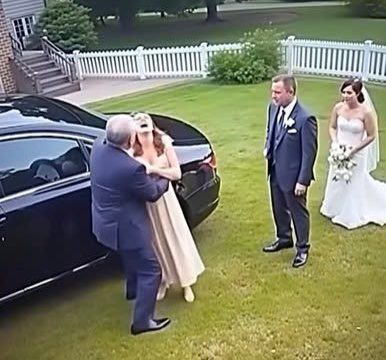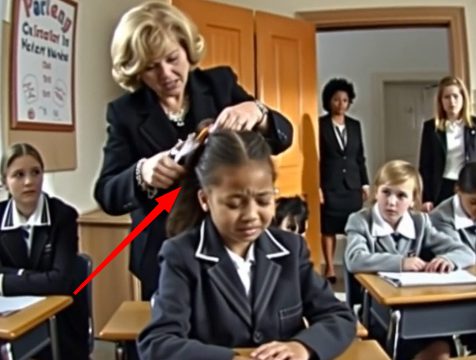It was still early on a calm Sunday morning when Officer Janet pulled into the airport parking zone with her K9 partner, Max. The sun was barely rising, spilling soft golden light across the pavement, and the air felt unusually still, as if the day had not yet decided what it was going to become. For Janet, mornings like this usually meant nothing more than a standard walk-through—a routine sweep of the terminals before crowds arrived. She expected quiet, perhaps a few early travelers, but certainly nothing that hinted at danger.

But just as they began their patrol, the unexpected broke through the silence. A faint sound—small, fragile—echoed across the nearly empty space. Max raised his head before she did, ears perked and body tensing. A moment later, Janet heard it too: the unmistakable sound of a child crying.
She scanned the terminal until her eyes landed on a little boy standing alone near the gate doors. He couldn’t have been more than five years old. He wasn’t moving—just standing there with tears streaking his cheeks, his tiny hands balled at his sides as if holding himself together. The sight made Janet’s heart tighten.
No child should ever look that lost.
She approached slowly, keeping her voice soft. “Hey, sweetie. Are you okay?”
At first, the boy didn’t answer. His lips trembled. His chin shook. His big, fearful eyes darted between Janet and Max before he lowered them to the floor. When he finally whispered a response, his voice was so faint that Janet couldn’t make out a single word.
What she could understand was that he was alone—no parent, no guardian, no adult anywhere in sight. And a child alone at an airport is almost never a simple mistake.
Max circled the boy with surprising gentleness. Although the K9 was trained for search, rescue, and protective work, he had never been particularly comfortable around young children. Yet something about this boy drew him in. He sniffed the child’s hand, pressed his nose against the boy’s fingers, and then sat beside him as though planting himself there on purpose.
Janet watched closely. Max only behaved like this when he sensed something serious—fear, danger, distress. Dogs didn’t need explanations. They felt things humans often overlooked.
“Max thinks something’s wrong,” Janet said, crouching down so she could meet the boy’s gaze. “You can talk to me, sweetheart. We’re here to help you.”
The child’s face crumpled. He burst into tears again, harder this time, heartbreaking sobs that shook his small shoulders. And then the truth came tumbling out in fragile, gasping words.
“My mom wouldn’t wake up,” he cried. “I tried calling her name, but she just wouldn’t wake up.”
A chill ran through Janet. She kept her voice steady, calm. “Sweetie, do you know how to get home? Can you show me where you live?”
The boy nodded through his tears. Without hesitation, he turned and began walking, his tiny legs moving faster than she expected. Janet followed close behind while Max trotted beside him, alert and focused. As they moved, she radioed for backup, reporting a possible medical emergency.
The boy’s home wasn’t far—just a short walk from the airport. The front door was unlocked. When they stepped inside, the house felt eerily quiet. Janet called out, but no one answered. The boy hurried down the hallway, leading them straight to a bedroom.
There, on the bed, lay a woman—motionless, pale, and clearly unresponsive.
For a split second, everything froze. Then Janet sprang into action, checking the woman’s breathing. She was alive, but barely. Her breaths were shallow. Her pulse was faint. This was no simple fainting episode.
Within minutes, paramedics arrived. They quickly assessed the situation, administered aid, and confirmed what Janet had already suspected: the woman had experienced a diabetic emergency during the night. If help had come any later—even by a few minutes—the outcome could have been devastating.
Standing in the hallway, Janet felt her chest loosen for the first time since hearing the boy cry. Relief washed over her as the paramedics carried the woman out, stabilizing her condition while preparing to transport her to the hospital.
The boy clung to Max, burying his small hands in the dog’s fur. Max stayed perfectly still, letting the child hold on, offering comfort the only way he knew how.
It was a moment that struck Janet deeply. She had originally assumed the boy was simply lost. But Max had sensed something more—an urgency, a hidden plea beneath the child’s tears. While she had been looking for an explanation, Max had already understood the truth.
After everything calmed down, Janet knelt beside her K9 partner and stroked his head. “Good work, buddy,” she whispered. Max gave a small chuff in response, as if acknowledging what they had accomplished together.
Later, when she spoke to the paramedics again, they told her the same thing: the boy saved his mother’s life by seeking help, and Max’s quick reaction helped ensure that everyone acted fast. Without the combination of a child’s desperation and a dog’s intuition, the outcome might have been tragic.
In the days that followed, Janet couldn’t stop thinking about the encounter. She had witnessed firsthand how instinct—whether from a frightened child or a loyal dog—can cut through confusion and lead straight to the truth. She had seen the power of connection between humans and animals, how it can guide their actions in ways that transcend explanation.
Max became something of a quiet hero at the station. But for Janet, the moment was more than a story to share—it was a reminder of why she joined the force in the first place. Her job wasn’t just about rules and patrols. It was about noticing the overlooked, listening to the unspoken, and being ready to protect those who couldn’t protect themselves.
And for one little boy, on one quiet Sunday morning, it was about finding help in the form of a woman in uniform and a dog who could sense what no one else could.
That day, a life was saved—not by luck, but by instinct, compassion, and a bond between a child and a K9 who refused to ignore his cries.





